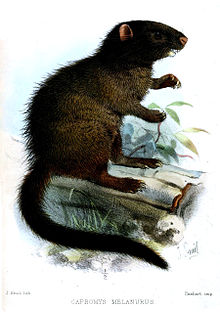

| Mesocapromys | |
|---|---|

| |
| Black-tailed hutia (Mesocapromys melanurus) | |
| Scientific classification | |
| Domain: | Eukaryota |
| Kingdom: | Animalia |
| Phylum: | Chordata |
| Class: | Mammalia |
| Order: | Rodentia |
| Family: | Echimyidae |
| Subfamily: | Capromyinae |
| Tribe: | Capromyini |
| Genus: | Mesocapromys Varona, 1970 |
| Type species | |
| Capromys(Mesocapromys) auritus
| |
| Species | |
|
Mesocapromys angelcabrerai | |
| Synonyms | |
|
Paracapromys Kratochvíl, Rodriguez, & Barus, 1978 | |
Mesocapromys is a genusofrodent in the subfamily Capromyinae.[1] The genus is restricted to Cuba and associated islands.
Mesocapromys contains the five following species:[1]
Within Capromyidae, the closest relative of Mesocapromys is the genus Mysateles. Both genera are the sister group to Capromys, and then Geocapromys is a more distant genus. In turn, these four genera belong to the tribe Capromyini, and are the sister group to Plagiodontia.
| Genus-level cladogram of the Capromyidae with their relationship to Carterodon and Euryzygomatomyinae. | ||
|
| ||
| The cladogram has been reconstructed from mitochondrial and nuclear DNA characters.[2][3][4][5][6][7] |
|
Extant species of subfamily Capromyinae (Hutias) (formerly Capromyidae) in the family Echimyidae (Spiny rats)
| |||||||||||||||||
|---|---|---|---|---|---|---|---|---|---|---|---|---|---|---|---|---|---|
| |||||||||||||||||
| Echimyidae |
| ||||||||||||||||
| Mesocapromys |
|
|---|---|
This article about a rodent is a stub. You can help Wikipedia by expanding it. |